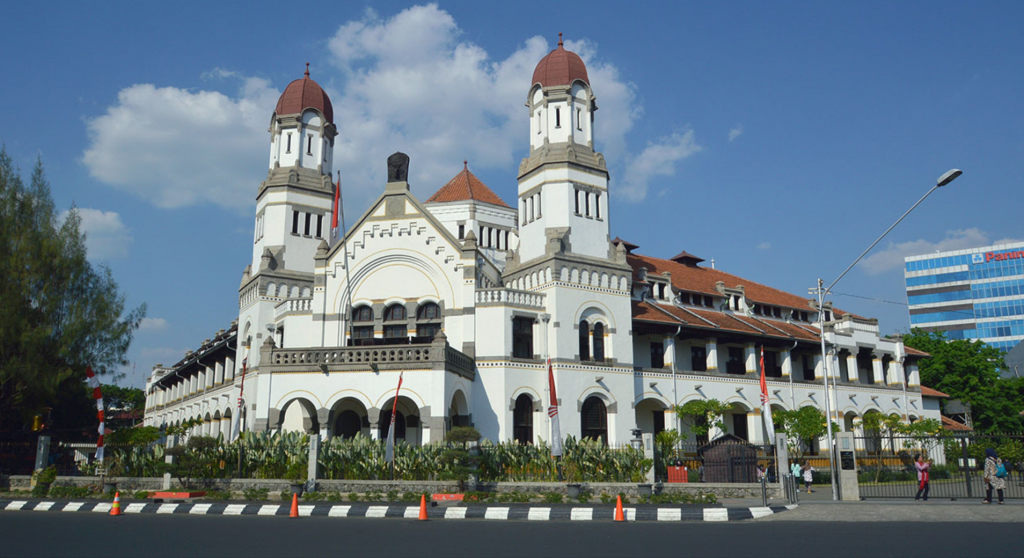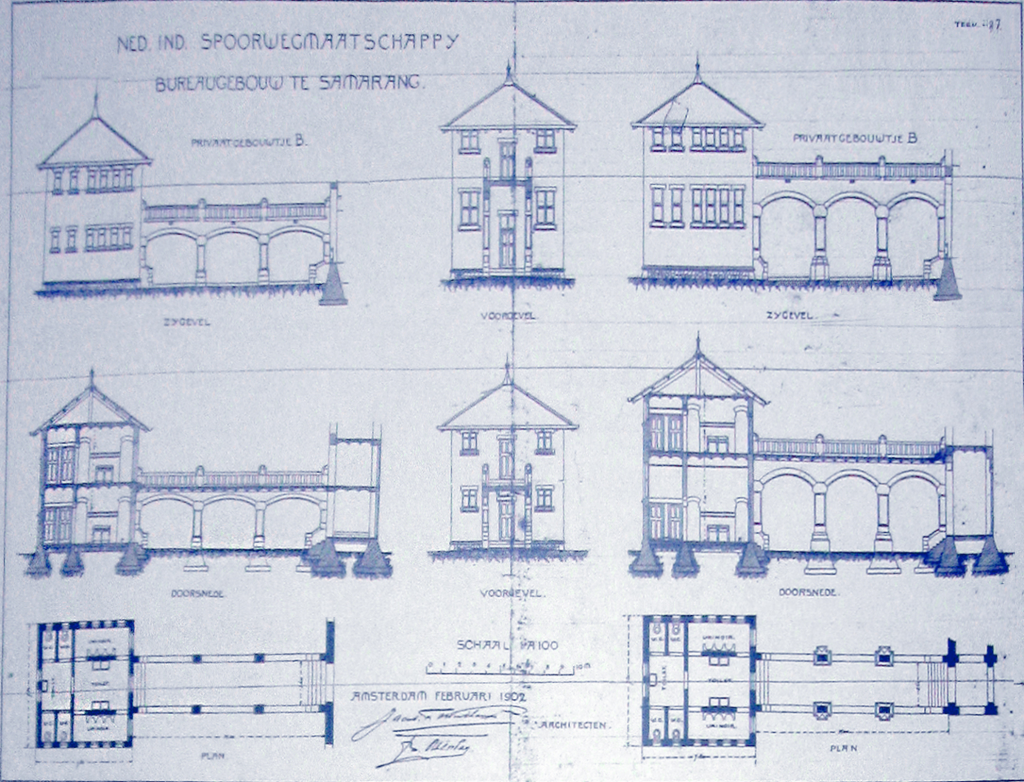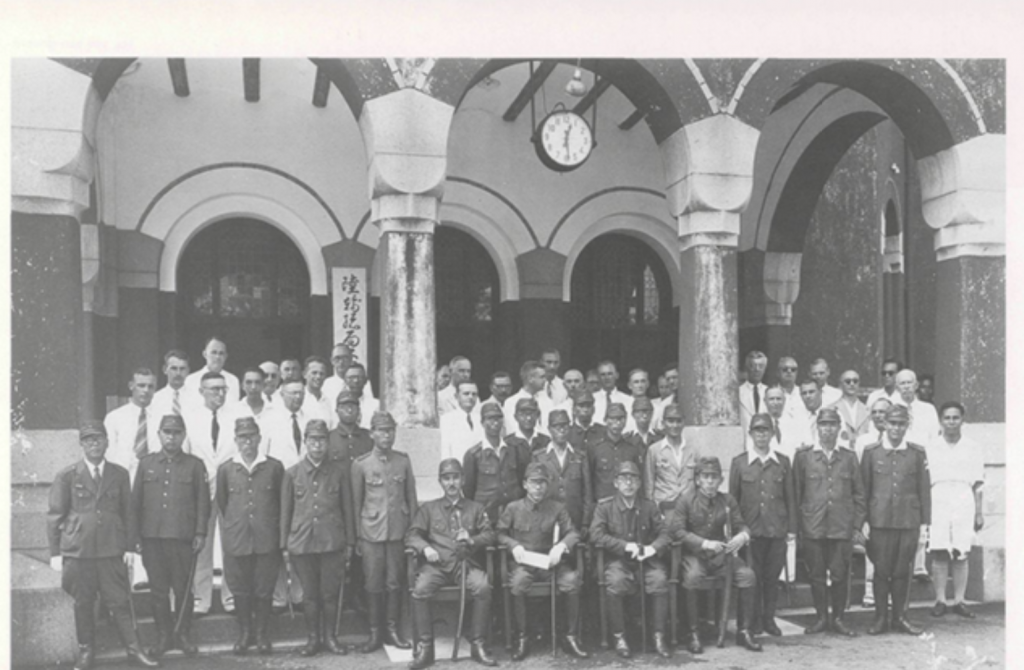

A Brief History of Lawang Sewu
Lawang Sewu is an old Dutch colonial building located in central Java island’s north coast city of Semarang in Indonesia and occupies a total space of 23m x 77m. . In Javanese language, one of the many languages in Indonesia, Lawang Sewu can be directly translated as “A Thousand Doors.” It was built on February 27th 1904 was completed in 1907 by the Dutch during the latter end of their 300 years of colonization in Indonesia. The building was initially designed for and functioned as the head office for the Nederlandsch-Indische Spoorweg Maatschappij, or the Dutch Indies Rail Company.
Lawang Sewu was designed by the Dutch architect Cosman Citroen and in the New Indies Style which is a modern architectural style used in the Dutch East Indies between the late 19th century through pre-World-War II 20th century. As common with Dutch colonial architecture in Indonesia at the time, the building itself was constructed with materials imported straight from the Netherlands. Although the name signifies a building with a thousand doors, only 928 currently remains today due to the looting that occurred during the war.
A Brief History of Indonesia
Perhaps when viewed through the lens of a foreign observer might one see the Dutch as colonizing a group of Indonesian aboriginals. However, culturally, Indonesia is home to hundreds of ethnic groups as it is not a homogenous country by any stretch of the imagination. The country itself is an archipelago of thousands of islands containing hundreds of diverse groups of people ranging from differences in religion, languages and skin colour. In fact, the modern motto of Indonesia is “Bineka Tunggal Ika”, which is essentially the country’s own version of “E Pluribus Unum.” Through the 300 years of Dutch Colonization, much of the attention took place in the central island of Indonesia called Java island. When colonialism breeds in a foreign land, it is not only the case that the local country is forcefully transformed to mold to the desire of the colonists but the colonists are inevitably transformed in return as well. Lawang Sewu is one example of how this might be as this Dutch colonial style architecture in Indonesia is a unique cultural phenomenon. The style does not exist elsewhere, even in the other former colonized countries due to it uniquely accommodating Dutch colonial architecture with respect to the Indonesian geography and culture. Such a case is clearly evident when examining the art and architecture produced at the time.
The Dutch’s First Few Impressions of Indonesia and Its Locals
Upon arrival to Indonesia, the Dutch were captivated by the temples that the ancient Hindus of Indonesia had built as well as the tropic landscapes which inspired artists as well scientists alike to inquire in its beauty. As architecture and art are often expressions of the needs and desires of the individual, it might prove to be beneficial to understand the perception of the Dutch towards a selection of Indonesian culture to get a better understanding of the power dynamics between the Dutch with the Indonesians. Architecture and art depictions often stem from this idea alone. The late Sir Thomas Stamford Raffles wrote in his book The History of Java when visiting Java island in Indonesia:
“He was peculiarly happy to find Sita seated over the door , which he declared to be a decisive proof of the sense and devotional excellence of the founders of this superb temple , which he very justly extolled , as far excelling in sculptural beauty and decorations , any thing he had ever seen or heard of in India , or could possibly imagine had existence any where . This surprise and admiration at the superiority of the Javan architecture , sculpture , and statuary , over those of India , was manifest in every Sepoy who saw them . Nothing could equal the astonishment of the man who attended me throughout this survey at every thing he saw ; nor did he fail to draw a very degrading and natural contrast between the ancient Javans , as Hindus and artists , and their degenerate sons , with scarce a remnant of arts , science , or of any religion at all.”[1]
It is clear from this excerpt above that Raffles held the ancient Indonesian culture to some degree of respect, except for the muslims that succeeded some of them. However, as colonialism is still oppressive in nature, that did not prevent the Dutch from subjugating the locals albeit in relative moderation in comparison to colonialism in other parts of the world. For example, many of the architectural buildings that were constructed such as Lawang Sewu did not include slave quarters, something that is very common in American plantation. However, segregation still did occur in the cities between the Dutch and the locals. Whether this is the reality or not, the impact of colonialism in Indonesia was routinely portrayed by the Dutch themselves as minimal as shown through the minimal disruption and resistance from Dutch paintings from the time.[2]
Anthony Payen, Borobudur (1835) The painting is very typical Dutch painting done from the 19th century.
The Dutch paintings from Indonesia are often about the landscapes themselves and the locals only there in so far as depicting scale and showing everyday life. The unique power dynamics between the Dutch and Indonesians are somewhat atypical when seen through a western lens of what colonization often is like. This unique power dynamics perhaps also contributes to how the Dutch colonial buildings are ultimately built and thus why they are a unique architectural phenomenon.

Dutch Colonial Architecture Evolution in Indonesia
Western colonial building typology can be found in many European colonial towns from Africa, Asia, to America. Wherever Europeans went on to colonize, they had the intention of bringing with them building technologies, materials, and design philosophies to places they settle in. However, what they often brought did not adhere to the local conditions of the place be it due to culture or climate. Overtime, the resulting architectural buildings were adjusted to the local conditions and thus unique local typologies ensued. Such was the case with Dutch Colonial Buildings in Indonesia as they gradually evolved over the many centuries of colonization mainly in response to the tropical climate.
Figure1 [3]
Therefore, as seen in the Figure 1 above, Dutch colonial buildings in Indonesia can be broadly categorized into four periods of style: Masonry European Style, The Indies Empire Style, The New Indies Style, and Art Deco Style. Furthermore, Table 1 and Table 2 below specify the differences in materials as well as construction systems between the four periods of style. According to Ardiyanto from the journal The Dutch Colonial Architecture of Buildings in Manado’s Old City: “ Dutch colonial architecture in the tropical area in the early 20th century adapted to the tropical climate. In addition to wind, the climate depends on the amount of total solar radiation received at a site. It is also influenced by the length of the daytime. The duration of the daytime will be longer than a night in the cities located in the north of the equator. Climate and environmental aspects are factors affecting the architectural products. Humans have a large enough capacity to adapt to a variety of climates and environments, including on the design of the building.”[4] As reasoned by Ardiyanto from the following quote, the stylistic choices of the Dutch in Indonesia, especially in the early 20th century, were not simply for aesthetic reasons but mainly functioned to adapt to the extreme Indonesian tropical climate. As Netherlands, from where the Dutch originated, has a completely different climate than Indonesia it should then stand to reason that the architects importing their building skills ought to iterate its buildings to be suitable for the local climate. As a point of fact, a direct one to one replica could result in unfavourable living conditions for its inhabitants. Therefore, the stylistic evolution of Dutch Colonial architecture as categorized earlier is simply a byproduct of centuries of problem solving in accordance with the Indonesian climate. This very reason also makes the Dutch Colonial architecture in Indonesia unique in the western colonial stage as no other countries share the exact weather conditions as Indonesia.
Japanese Reign during WWII
During the Japanese takeover of Indonesia in 1942, the building was repurposed as a headquarters for the Japanese military for their transportation division. The basement of the building was used as a drainage channel, detention and torture room for Indonesians. It was notoriously known as being Japan’s most brutal prison in Indonesia. On October 14th, 1945, after Indonesia declared their Independence, the bloody “Battle of Semarang” took place in Lawang Sewu for a period of 5-days. The battle took place between AMKA (Angkatan Muda Kereta Api), directly translated as the Railway Youth Force, opposing the Kempeitai, Kidobutai, the Japanese Military Police and Strike Force. As a result of this bloody battle, many were tortured and executed at Lawang Sewu during this battle.[5] In 1950, the Tugu Muda monument was erected as commemoration of those who died and suffered in the 5-days battle at Lawang Sewu.

Speaking from experience
Anecdotally speaking, it is unfortunate that when reflecting on Indonesia’s Dutch colonized past, the topic is almost always in relation to how the Japanese colonized Indonesia afterwards. The Dutch approximately 300 years of colonization is almost unanimously preferred by the population when compared to the 3 brief years of Japanese colonization. For better or for worse it is partly because of this reason that there is often little to no animosity in present times towards the Dutch in the public eyes as they are almost always compared to the Japanese. The Dutch colonization is sometimes even seen to pave the way for modernized Indonesia as they built infrastructure and helped educate the masses, while Indonesians themselves having to forfeit natural resources. Perhaps it is the power dynamics between the colonialists and colonized or the Indonesian generally glass half full cultural mindset, but Lawang Sewu as well as other Dutch colonial buildings are often preserved and reused as it is now without much negative cultural baggage.
What is Lawang Sewu’s current usecase
Shortly from Indonesia’s independence all the way until 1994, the building had been owned by the PT Kereta Api Indonesia to be primarily used as their main office as well as other agencies like the Java Ministry of Transportation. However the building was left empty and neglected in 1994 and after the building had been vacant for many years, the PTKA’s Heritage and Conservation Department, or Indonesia’s major operator of public railways, decided to renovate it in hoping to revitalize it. Although the building had been renovated and now in pristine condition, the use case does not extend far beyond it simply being a museum for tourist attractions. It currently also became popular as a wedding venue. Because it currently is owned by the PTKA, Indonesia’s public railway company, the primary use case for Lawang Sewu is to display the history of trains and not much of colonialist history. [6]
Also, due to the many tragedies that happened in this building during the Japanese occupation and also the fact that Indonesians are highly superstitious, the site has gained much attraction to locals for it being possibly haunted. In fact, Lawang Sewu is included in Asia’s second most haunted building, only second to Hong Kong’s former school building. Some locals often report that they have heard screams of pain or fear coming out of an old well in the yard of the Lawang Sewu. The prison rooms also allegedly reek of fresh blood and headless ghosts from the Japanese beheadings that occurred from the 5-days battle at Lawang Sewu.
Conclusion
Lawang Sewu is a byproduct of centuries of Dutch colonial architectural innovations and a culmination of centuries of stylistic evolution. There are two driving factors as argued by this essay that proved to be the underlying reasons as to how the Dutch colonial architecture eventualized and resulted in a culturally unique architecture not seen anywhere else in the world. The relationship between the locals with the Dutch helped inspire them to create novel building styles like Lawang Sewu. Secondly, Lawang Sewu is an example of 300 years of Dutch colonial architectural evolution in response to contextualizing Dutch architecture with Indonesian tropic climates and can be categorized as being an example of the third Dutch colonial style of the The New Indies. Gradually, over the period of 300 years, Dutch colonial architecture in Indonesia evolved mainly in response to facilitating against the tropic conditions.
Notes
1. Sir Thomas Stamford Raffles, The History of Java (London: J. Murray, 1830) 28
2. Susie Protschky, Images of the Tropics: Environment and Visual Culture in Colonial Indonesia (Brill, 2011)
3. Kubota Tetsu, Sustainable Houses and Living in the Hot-Humid Climates of Asia (Springer Singapore, 2018) 13-23
4. V A Kumurur and D M Tampi, The Dutch colonial architecture of buildings in Mando’s Old City: A response to the coastal tropical climate (IOP Publishing LTD, 2018)
5. PT Kereta Api Indonesia, 2017, https://heritage.kai.id/page/lawang-sewu.
6. Ridwan Aji Pitoko, “Lawang Sewu, Ikon Arsitektur Semarang Kombinasi Desain Tropis Dan Eropa” August 17, 2016, https://properti.kompas.com/read/2016/08/17/144423321/lawang.sewu.ikon.arsitektur.semarang.kombinasi.desain.tropis.dan.eropa?page=all
